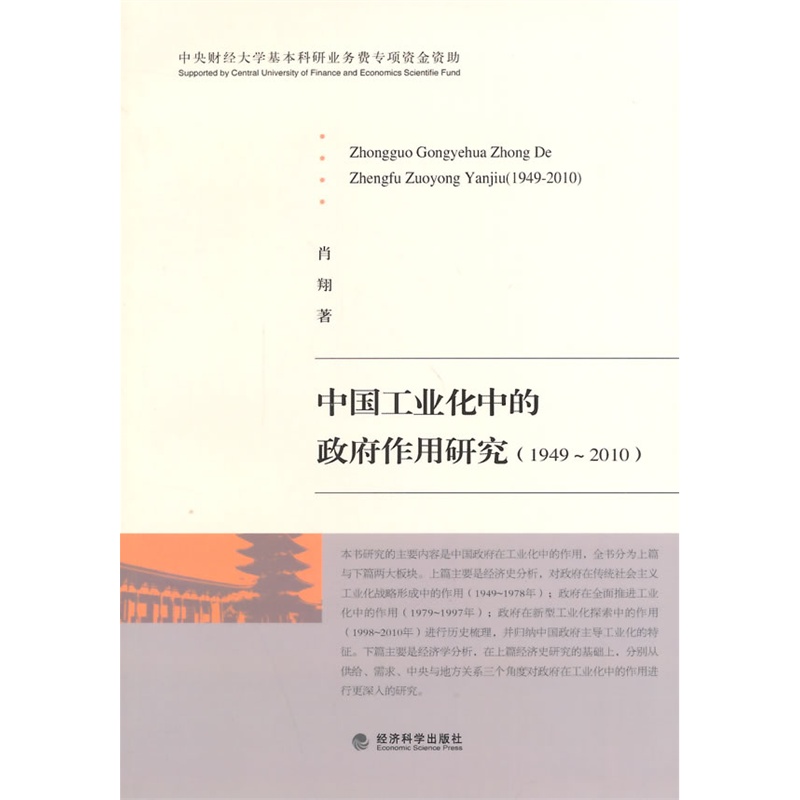
. > WHAT'S NEW > BOOKS
Government adapts its role with historical context's changes
Author : Wu Li Source : Chinese Social Sciences Today 2014-08-21

In the 65 years that have passed since the establishment of the People’s Republic of China in 1949, the industrialization of China has gone through two stages and two transformations.
In the period from 1949 to 1978, China started on the path to industrialization to become strong, which necessitated the rapid establishment of an independent and integrated industrial system in order to safeguard national security. As a consequence, priority was given to industrial development based on public ownership and planned economy.
In the second stage from 1978 to 2014, China accelerated industrialization and improved the industrial structure to become prosperous. The main task for this period is to solidify gains and optimize resource allocation in order to increase the incomes of ordinary people.
There are two significant issues that so far have not been fully solved: the relationship between government and markets, and the relationship between central and local government. And these two aspects are what Xiao Xiang probes in his book Study on the Role of Government in Industrialization of China (1949–2010).
The book gives a retrospective of the history from 1949 to 2010, analyzing the features of industrialization for each stage and their influences on the central-local relationship. The relationship between central and local government, as observed in the book, had to be adapted to meet various requirements at different stages and under different strategies. The book also examines fiscal decentralization which, according to empirical studies, can boost industrialization. At the same time, the more decentralized the government is, the bigger difference there will be in the levels of industrialization across all regions. It is obvious from the book that decentralization of the central power is a process of dynamic equilibrium.
In addition, based on historical analysis, the book points out that when the central government plays a leading role in the process, it will have an impulse for investment, whether centralized or decentralized, but if the process is led by local governments, which bear no responsibility for overall balance, competition in different areas will be intensified.
To change the growth model in the post-industrialization period, China needs to transform the functions of government, the book argues. In this way, it can avoid a dilemma in which when controlled, the process will be stagnant but when unregulated, the process will be in disorder.
The book can be divided into two parts. In Part I, it reviews the process of industrialization and the role of government in different stages for the past 61 years through historical and empirical analysis. In Part II, it relies on economic theories and mathematical models while using methods of inference and deduction to verify related conclusions.
However, the two approaches lead to the same conclusion that the role of government in industrialization follows an inverted U curve. That is why planned economy was implemented in the 1950s, market reforms were promoted from 1978 and market was defined as playing the decisive role during the Third Plenum of the 18th Central Committee of the CPC.
The Chinese version appeared in Chinese Social Sciences Today, No. 633, Aug 13, 2014.
Wu Li is from the Institute of Contemporary China Studies at the Chinese Academy of Social Sciences.
Translated by Ren Jingyun
Ye Shengtao made Chinese fairy tales from a wilderness
Ye Shengtao (1894–1988) created the first collection of fairy tales in the history of Chinese children’s literature...
-
How northern ethnicities integrated into Chinese nation
2023-09-18
-
Mogao caves
2023-09-12
-
Mogao Grottoes as ‘a place of pilgrimage’
2023-09-12
-
Time-honored architectural traditions in China
2023-08-29
-
Disentangling the civilizational evolution of China
2023-08-28
-
AI ethics in science fiction
2023-08-23













 2011-2013 by www.cssn.cn. All Rights Reserved
2011-2013 by www.cssn.cn. All Rights Reserved